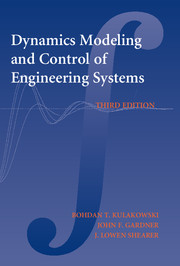Book contents
- Frontmatter
- Contents
- Preface
- Dynamic Modeling and Control of Engineering Systems
- 1 INTRODUCTION
- 2 MECHANICAL SYSTEMS
- 3 MATHEMATICAL MODELS
- 4 ANALYTICAL SOLUTIONS OF SYSTEM INPUT–OUTPUT EQUATIONS
- 5 NUMERICAL SOLUTIONS OF ORDINARY DIFFERENTIAL EQUATIONS
- 6 SIMULATION OF DYNAMIC SYSTEMS
- 7 ELECTRICAL SYSTEMS
- 8 THERMAL SYSTEMS
- 9 FLUID SYSTEMS
- 10 MIXED SYSTEMS
- 11 SYSTEM TRANSFER FUNCTIONS
- 12 FREQUENCY ANALYSIS
- 13 CLOSED-LOOP SYSTEMS AND SYSTEM STABILITY
- 14 CONTROL SYSTEMS
- 15 ANALYSIS OF DISCRETE-TIME SYSTEMS
- 16 DIGITAL CONTROL SYSTEMS
- APPENDIX 1 Fourier Series and the Fourier Transform
- APPENDIX 2 Laplace Transforms
- APPENDIX 3 MATLAB Tutorial
- APPENDIX 4 Simulink Tutorial
- Index
14 - CONTROL SYSTEMS
Published online by Cambridge University Press: 05 June 2012
- Frontmatter
- Contents
- Preface
- Dynamic Modeling and Control of Engineering Systems
- 1 INTRODUCTION
- 2 MECHANICAL SYSTEMS
- 3 MATHEMATICAL MODELS
- 4 ANALYTICAL SOLUTIONS OF SYSTEM INPUT–OUTPUT EQUATIONS
- 5 NUMERICAL SOLUTIONS OF ORDINARY DIFFERENTIAL EQUATIONS
- 6 SIMULATION OF DYNAMIC SYSTEMS
- 7 ELECTRICAL SYSTEMS
- 8 THERMAL SYSTEMS
- 9 FLUID SYSTEMS
- 10 MIXED SYSTEMS
- 11 SYSTEM TRANSFER FUNCTIONS
- 12 FREQUENCY ANALYSIS
- 13 CLOSED-LOOP SYSTEMS AND SYSTEM STABILITY
- 14 CONTROL SYSTEMS
- 15 ANALYSIS OF DISCRETE-TIME SYSTEMS
- 16 DIGITAL CONTROL SYSTEMS
- APPENDIX 1 Fourier Series and the Fourier Transform
- APPENDIX 2 Laplace Transforms
- APPENDIX 3 MATLAB Tutorial
- APPENDIX 4 Simulink Tutorial
- Index
Summary
LEARNING OBJECTIVES FOR THIS CHAPTER
14–1 To characterize the steady-state behavior of a system through analysis of the system transfer function.
14–2 To evaluate the steady-state disturbance sensitivity of a system.
14–3 To understand the trade-off between transient and steady-state performance specifications in control system design.
14–4 To select gains of a proportional–integral–derivative controller based on open-loop system performance.
14–5 To design an appropriate cascade compensator based on steady-state and transient performance specifications.
INTRODUCTION
In Chap. 1, it was pointed out that negative feedback is present in nearly all existing engineering systems. In control systems, which are introduced in this chapter, negative feedback is included intentionally as a means of obtaining a specified performance of the system.
Control is an action undertaken to obtain a desired behavior of a system, and it can be applied in an open-loop or a closed-loop configuration. In an open-loop system, shown schematically in Fig. 14.1, a process is controlled in a certain prescribed manner regardless of the actual state of the process. A washing machine performing a predefined sequence of operations without any information and “with no concern” regarding the results of its operation is an example of an open-loop control system.
In a closed-loop control system, shown in Fig. 14.2, the controller produces a control signal based on the difference between the desired and the actual process output. The washing machine previously considered as an open-loop system would operate in a closed-loop mode if it were equipped with a measuring device capable of generating a signal related to the degree of cleanness of the laundry being washed.
- Type
- Chapter
- Information
- Dynamic Modeling and Control of Engineering Systems , pp. 356 - 388Publisher: Cambridge University PressPrint publication year: 2007

